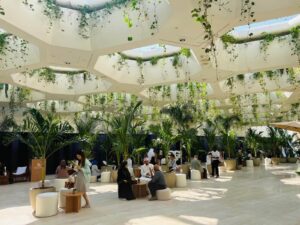You may see Japanese office layout in TV that usually desks are connected to nearby colleagues’ desks without partitions or cubicles.
Japanese companies have such open office layout. Western countries may better because you are often given a larger space with your own cubicles or even your own room.
In Japan the most common office type is an open room layout filled by full of desks. Usually Japanese firms do not have cubicles, instead, Japanese employees sit right next to each other. Japan is a small country, so unless you have an executive level position, you are most likely not going to have a spacious private office.
You may wonder why such office layout is common in Japan. It seems many people are okay with it on the surface but quite afew people even Japanese claiming. They claim it’s unproductive to have such an open office layout, simply it’s annoying, etc. But some people find a benefit on it, such as convenience to communicate with their colleagues.
Everyone’s desks pushed together in little islands to work together at.
Again, in theory this is supposed to encourage employee bonding and teamwork, but the reality is that it just ends up making people hate their job even more. Constantly feeling like you’re being watched by your bosses, coworkers, and anyone else who comes in just makes you paranoid. In fact, it can even lower productivity since people feel like they need to be seen as constantly working, so they take longer to complete assignments.
However, your performance may increase under such situation.

You can easily communicate with colleagues and can smoothly share the conversations in order to solve any issues. And you can report the significant matters more quickly to your boss or colleagues.
But main reason what I can imagine is just because of concern of managements.
As internal control point of view, such layout is very important in order to control activities of office. “Internal Control” is most prioritized issue for compliance in many Japanese companies.
From another point of view, it is also said that has roots in traditional Japanese house that have little privacy.
Ordinary Japanese old houses have a very open structure. Rooms are separated by Fusuma, sliding panels made of paper. It’s just a paper, so you’ll easily notice when people in other rooms are speaking. It’s even possible to hear what they are talking about in many cases.
It’s up to you whether you believe or not….





